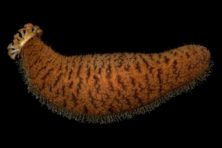Sea Cucumbers and Brain Plasticity
- Share
- Tweet
- Pin
- Share
• Ever heard of “sea cucumbers?” They’re cucumber-shaped relatives of starfish and sea urchins, but to look at them you would not believe the relationship. Sea cucumbers grow to be a foot or more in length and have bodies covered with short spines and/or warts. They breathe in an unusual way – by pumping water into and out of the anus, the lining of which serves as gills. Little “tube feet,” or suckers, along their undersurface enable them to move slowly along the ocean floor (starfish and urchins also move by tube feet).
When threatened by predators, they exude a toxic slime, and if this does not work, they eject their digestive tract out the anus. The expelled gut distracts the predator, and later the cucumbers develop a new gut.
Some sea cucumbers are associated with the Pearl Fish, a small, eel-like fish that lives in the cucumber’s anus. These little fish spend daytime backed back into the anus, with the head sticking out, and they leave at night to forage for food. Apparently the sea cucumber is not adversely affected by its presence. In the morning, after the Pearl Fish is finished foraging, it finds its cucumber and backs into its anus/garage. (www.reefed.edu.au; other sources)
• Studies suggest that over the lifetime of a person, the brain continually rewires itself as a result of experience. For example, the brain circuits of most veterans with Post-Traumatic Stress Disorder have been modified due to experiences in combat. But because the brain is highly plastic, with effort the veteran’s brain can rewire itself to deal with the non-combat environment.
Brain plasticity is also reflected in recent studies showing that a teenager’s IQ (intelligent quotient) can rise or fall as many as 20 points, depending on experience. IQ tests are designed to measure language skills, spatial ability, arithmetic, memory, and reasoning, with a score of 100 considered to be average. The plasticity of the brain is something not to be taken for granted, and if you start out with an IQ of 100 and become a couch potato, your IQ is likely to fall. Use it or lose it. (Brain in the News, Dec., 2011)
• Autism continues to be shrouded in mystery. In a small postmortem study, neuroscientists counted the number of brain cells in the prefrontal cortex of seven autistic boys between the ages of two and sixteen. Postmortem counts were also made in six non-autistic boys of similar ages. The autistic boys had on average 67 percent more brain cells than the non-autistic children. It is known that in the late fetus, and even in young children, excess neurons must be “pruned” (killed off) to ensure that the correct number of neurons remain to establish and maintain proper connections. The big question is whether autistic brains generate more neurons or if they have a malfunctioning “pruning” process. (Journal of the American Medical Association, Nov. 9, 2011)
• Within about six months of age, when infants begin to babble as they try out their speaking skills, they focus on the mouths of individuals speaking to them. It’s as if they are lip-reading. Once they start to blurt out words or simple statements, their gaze shifts from a speaker’s mouth to the speaker’s eyes. It appears that babbling babies try to match up what adults say with how they say it by watching the speaker’s mouth, but “budding talkers can afford to look for communication signals in speakers’ eyes.” (according to a study in the Proceedings of the National Academy of Sciences reported online Jan. 17, 2012). The study also found that by two years of age, children with autism avoid eye contact and focus on speakers’ mouths. The significance of this is under further investigation.


